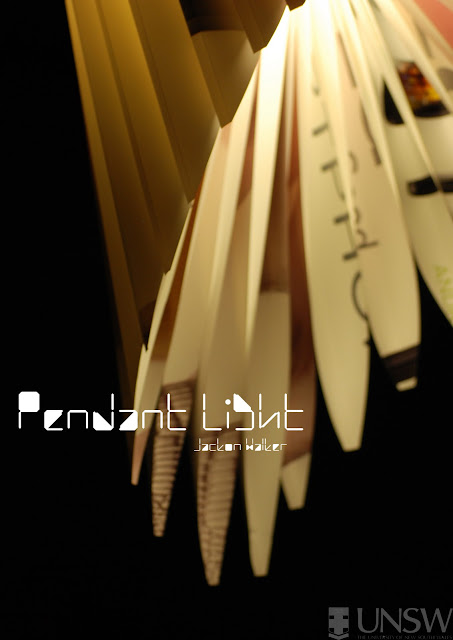Studio by Jackson Walker
Wednesday 19 October 2011
Tuesday 18 October 2011
Utilizing Utility: Rationale
This lamp prototype is made out of upcycled synthetic paper advertising posters, metal spacers and steel wire. Through staying true to the limits of the material, symmetry and repeating patterns I was able to create my lamp using structured folding techniques and straight lines protruding from a circular base to still create the dynamic form of this light It displays a contrast between a rigid and structured exterior to an organically shaped interior. The layers that form the light shade are constructed from the same base shape and the length is then altered- this in turn has produced a cutting diagram that is materially efficient as each piece can be tessellated against the next on a flat sheet.
The shape of this pendant lamp is similar to that of a traditional lamp, however contrasts to its structural design. it has been successfully executed in a way that it displays and also hides varying facets of the light from different positions in a room. However, still attains a warm distilled glow from all angles of perspective.
Thursday 15 September 2011
Peer Comments
Camilla Kordek- Appearance Model ( Hidden Vines Garden Fork)
Mitchell Harris- Product Storyboard (Incognito Grater)
Cherrie Fillisia- Project 1 (Mortar and Pestle)
Ghina Ali- Luxury at your hands. (Letter Opener)
Dennis Lee- Vigo Cheese (Cheese Grater)
Bill Moggridge. What is Design?
Mitchell Harris- Product Storyboard (Incognito Grater)
Cherrie Fillisia- Project 1 (Mortar and Pestle)
Ghina Ali- Luxury at your hands. (Letter Opener)
Dennis Lee- Vigo Cheese (Cheese Grater)
Bill Moggridge. What is Design?
In the latest video I watched, Bill Moggridge explores the definition of design. He defines design as anything altered by man, and thus alludes to how broad design really is. There is no one category of design, but rather, it design itself branches out to reach the fashion industry, interior shapes and even engineering. From architecture, to industrial design, to interior design, Moggridge really covers many interesting aspects, focusing on design principals in this 55 minute video.
First Moggridge introduces us to both good and bad design. There is a segment where he discusses kitchen tools, and how they are categorised as “smart design”. This is because the kitchen utensil is easy to use, even for older people, people with arthritic hands. He draws attention to how a good design to the disabled is also good design to others. The example shown of bad design was the mention of the i-mode service. This service is used for purchasing soft drinks with mobile phones, and whilst some may marvel at the ingenuity of it, the designers didn’t cater for their target market, and thus, didn’t adhere to their needs. There were several issues with it, some of which included the long processing time and the confusing nature of it. Judging from a designers perspective, there was insufficient prototyping done before this was released, and there may have been miscommunications during the design process too.
This leads Moggridge to discuss the design process and its concepts. There are two main concerns. The first being understanding the consumer, and the second being prototyping. To understand people, there are three categories: people (desirability), business (viability) and technology (feasibility). To fully understand a consumer, all three of these branches must be put forward for thought. Moddridge concludes his explanation of the design process with an overview of the four things we must do and that is; to assess the flow of analysis, observe, ask and to experiment. The other half of the design refers to prototyping. There are three stages to prototyping; inspire, evolve and to validate. The constantly evolving technology in today’s world allows for easy simulations of designs, showcased on computer in its 3D form before even needing to construct a physical model. However, it is important that a physical model is made at some stage to examine all areas and to make adjustments.
Bill Moggridge also covers three expanding contexts relating to design. This would be the Personal, Social and Environmental aspects, each a crucial part of any designers mentality. Design is expanding towards the well being of people and their health, hence this heavily concentration on living more sustainably. Personal design concentrates on the consumer themselves. Social refers to the design for impact, to change something for improvement. Environmental looks at how the materials the object is made up of affects our world.
This video was very entertaining to watch and I loved hearing the design process being broken down into categories. It really helped me to understand the whole notion of design, as opposed to what a designer does.
Tuesday 13 September 2011
Subscribe to:
Posts (Atom)



